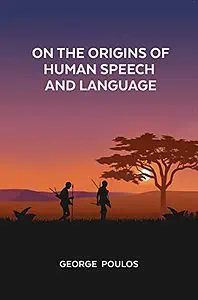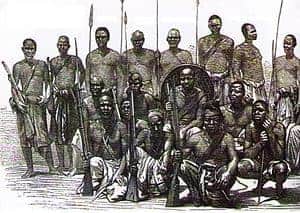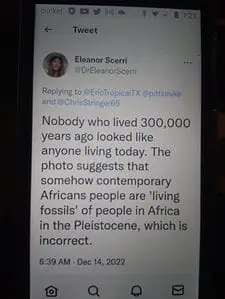Eleanor Scerri criticizes South Africa’s top linguist for portraying African tribe as “fossil looking”
 Eleanor Scerri, famed archaeologist and antiquities expert for Western Africa, is not happy about a new article published by a colleague in the general field of anthropology.
Eleanor Scerri, famed archaeologist and antiquities expert for Western Africa, is not happy about a new article published by a colleague in the general field of anthropology.
George Poulos is professor emeritus of the University of South Africa. From his bio:
George Poulos is Professor Emeritus at the University of South Africa (UNISA). He obtained his BA Hons and MA degrees at the University of the Witwatersrand, and his PhD at Rhodes University. His research interests have been in the fields of phonetics and linguistics. He has specialized in the descriptive analyses of African Languages… He has received numerous awards, research grants and scholarships, amongst them, the ‘South African Man of the Year Award for Excellence…
He also speaks fluent Zulu and is well-versed in a number of other African tongues.
His latest book was released in June of 2021, “On the Origins of Human Speech and Language.” From the description, published at The Conversation:
 When did humans first begin to speak, which speech sounds were uttered first, and when did language evolve from those humble beginnings? These questions have long fascinated people, especially in tracing the evolution of modern humans and what makes us different from other animals. George Poulos has spent most of his academic career researching the phonetic and linguistic structures of African languages. In his latest book, On the Origins of Human Speech and Language, he proposes new timelines for the origins of language. We asked him about his findings.
When did humans first begin to speak, which speech sounds were uttered first, and when did language evolve from those humble beginnings? These questions have long fascinated people, especially in tracing the evolution of modern humans and what makes us different from other animals. George Poulos has spent most of his academic career researching the phonetic and linguistic structures of African languages. In his latest book, On the Origins of Human Speech and Language, he proposes new timelines for the origins of language. We asked him about his findings.
Professor Poulos makes many controversial claims, such as:
Research carried out for this study indicates that the first speech sounds were uttered about 70,000 years ago, and not hundreds of thousands or millions of years ago, as is sometimes claimed in the literature…
The transformation of Homo sapiens (modern humans) from a “non-speaking” to a “speaking” species happened at about the same time as our hunter-gatherer ancestors migrated out of Africa.
Language skills may not have fully developed until Homo sapiens left Africa for Eurasia 50,000 years ago
Poulos goes on to assert that the vocal tract in modern humans took much longer to develop than is most commonly believed. Specifically:
 At the time of the “out of Africa” migration, the only part of the vocal tract that was physiologically developed to produce speech sounds was the oral cavity (mouth area)…
At the time of the “out of Africa” migration, the only part of the vocal tract that was physiologically developed to produce speech sounds was the oral cavity (mouth area)…
The only speech sound that could be produced entirely in the mouth at the time was the so-called “click” sound.
Of course, click sound languages are most common today in southern African tribes such as the KhoiSan of South African and Namibia. But such languages can also be found in some Bantus in parts of Botswana and Tanzania.
He hypothesizes simple language skills emerged around 50,000 years ago, and that grammar developed fully by about 20,000 years ago.
Of course, such a view could be interpreted as suggesting Africans might be less advanced linguistically. A number of Bantu languages are tonal, which could prove challenging for Western language speakers. But grammar in African languages can often be less complex.
For the most widely spoken African language, from Wondriumdaily.com:
Swahili is a relatively easy language. Irregular constructions, for example, are almost oddly rare. There are no sounds that are hard to pronounce.
“Nobody who lived 300,000 years ago, looked like anyone living today” — Dr. Eleanor Scerri, Univ. of Malta
Eleanor Scerri is widely considered to be one of the top paleo-anthropologists in the world. Scerri is originally from Malta. From her bio:
 tenured Associate Professor (W2) and the ‘Lise Meitner’ Independent Group Leader at the Max Planck Institute for the Science of Human History in Jena, Germany where I head the Pan-African Evolution and ERC funded IslandLab research groups.
tenured Associate Professor (W2) and the ‘Lise Meitner’ Independent Group Leader at the Max Planck Institute for the Science of Human History in Jena, Germany where I head the Pan-African Evolution and ERC funded IslandLab research groups.
She has led numerous excavation digs in western African nations, one of particular interest to readers of this site, involved Homo iwoeleruensis in Cameroon. See our article, from Jan. 2020, “Cameroon burial site shock: Rare Haplo-type Afros likely descended from another Hominid species.”
Scerri is close friends with Chris Stringer of the London Natural History Museum. The two have published a number of papers together. They transformed Recent Out of Africa origins hypothesis, dominate for 4 decades, into Pan-African Multiregional model, acknowledging archaic Hominin admixture outside of Africa with Neanderthals and Denisovans.
From her best-known 2018 paper co-authored with Stringer,
Did Our Species Evolve in Subdivided Populations across Africa, and Why Does It Matter?
 The view that Homo sapiens evolved from a single region/population within Africa has been given primacy in studies of human evolution.
The view that Homo sapiens evolved from a single region/population within Africa has been given primacy in studies of human evolution.
However, developments across multiple fields show that relevant data are no longer consistent with this view.
We argue instead that Homo sapiens evolved within a set of interlinked groups living across Africa, whose connectivity changed through time.
Genetic models therefore need to incorporate a more complex view of ancient migration and divergence in Africa.
“Stop using photos of African people in traditional dress…”
Scerri Tweeted out on December 13:
 Wow. So according to this, humans couldn’t speak before they left Africa, and it was down to eating fish. I thought this was all discredited 20 years ago. #Paleoanthropology please discuss.
Wow. So according to this, humans couldn’t speak before they left Africa, and it was down to eating fish. I thought this was all discredited 20 years ago. #Paleoanthropology please discuss.
But it wasn’t just the linguistic hypotheses that attracted the ire of such a well-known paleo-anthropology scientist. Rather, Dr. Eleanor Scerri bristled at Poulos’s images used in his book. Responding to British archaeologist Mike Pitts, who raised the objection, “There’s also a deeper problem with the way photos of contemporary Africans are used to illustrate stories about early humans…” Scerri Tweeted:
Nobody who lived 300,000 years ago looked like anyone living today. The photo suggests that somehow contemporary Africans people are ‘living fossils’ of people in Africa in the Pleistocene, which is incorrect.
Some of Scerri’s supporters were even more ademant:
Rachel King, an archaeologist and ceramics expert with University College of London, wrote:
for the love of god stop using photos of African people in traditional dress to illustrate articles about hominin evolution



“for the love of god stop using photos of African people in traditional dress to illustrate articles about hominin evolution”
Then for the love of God stop insisting that Homo sapiens owes its evolutionary existence to Africa and that “we are all Africans.”